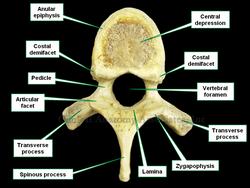|
The [transverse processes] are two lateral bony processes found in most vertebrae, with the exception of the coccygeal vertebrae. Transverse processes have regional variations. The transverse processes in the cervical vertebrae are heavily modified with anterior and posterior roots forming the boundaries of the foramina transversaria. They are "gutter-shaped" to accommodate the spinal nerves, and angled at 60 degrees anteriorly with a 15 degree inferior tilt. In the thoracic region the transverse processes point posterolaterally and present with an articular facet (costal facet) for the costal tubercle of a rib, forming the costotransverse joint. The transverse processes of T11 and T12 do not have a costal facet. |
|
| The transverse processes in the lumbar region point slightly posterolateral, and they are larger. The longest transverse processes in the lumbar region are those of L3. The transverse processes of L5 are atyical in that they also point superolaterally at almost 45 degrees. This is because these transverse processes are attached to the posterior superior iliac spine and iliac crest by the iliolumbar ligament, contributing to the prevention of forward displacement of L5 over S1.
The sacral transverse processes contribute to the larger mass of the sacrum fusing to form the intermediate sacral crest on its posterior surface. Thanks to Dr. Mary M Tuchscherer for her comments and improvement of this article. |
|
| Back to MTD Main Page | Subscribe to MTD |
